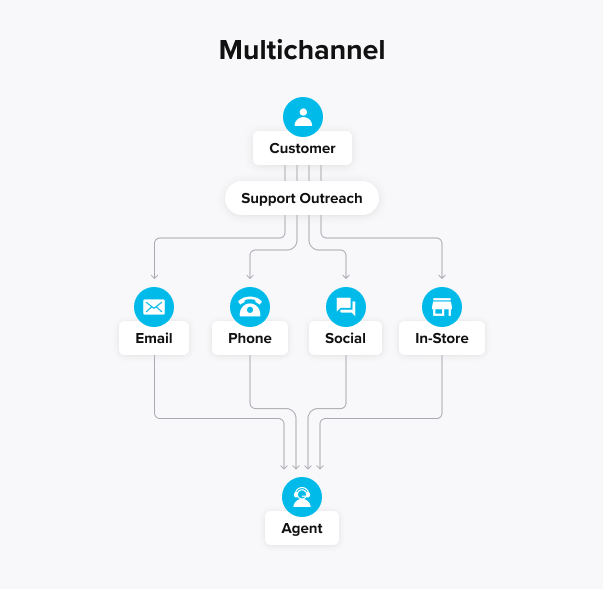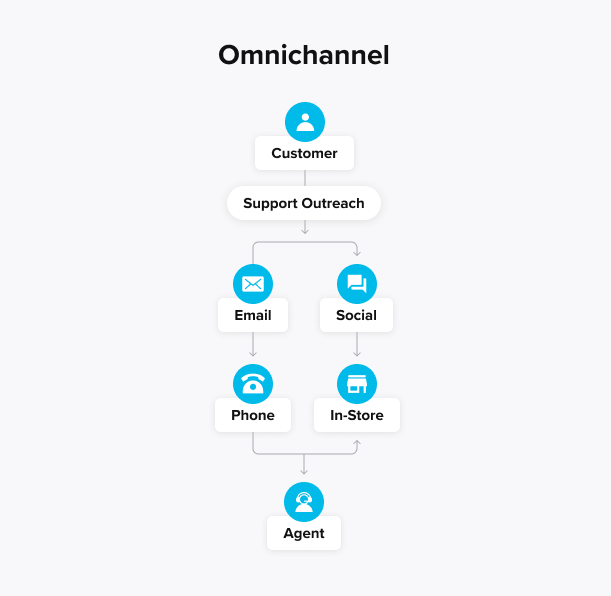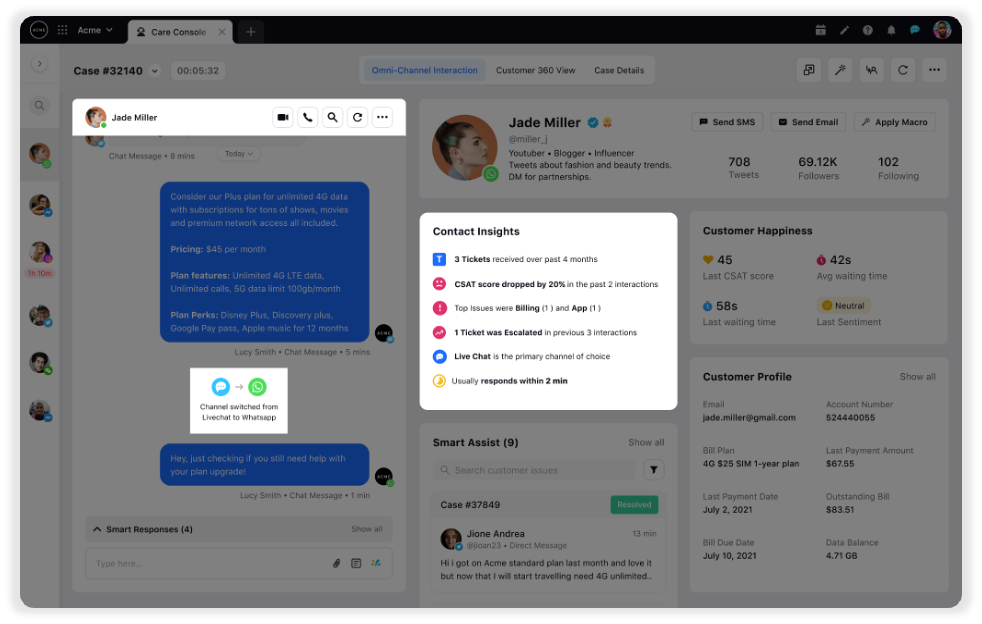- What is contact center experience?
- Contact center vs. call center experience
- Top 3 benefits of a seamless contact center experience
- Types of contact center experiences for organizations
- Best practices for an effective contact center experience
- Why should companies opt for omnichannel contact center experience?
- Dazzle your customers with a unified contact center experience
What is contact center experience?
Contact center experience is the sum of all customer service interactions with a business through various communication channels such as phone calls, emails, live chat and social media engagement.
It starts with a customer calling to inquire about a product and then receiving follow-up support through email after purchase. More than just solving problems; it shapes the entire journey a customer takes with a company, from first contact to post-purchase assistance.
This experience is built on several key components:
1) Multi-channel communication: Using convenient platforms such as quick call support, live chat and screen-share demos to shape the contact center experience by offering customers their preferred method of communication, ensuring they feel heard and valued.
2) Technology: Implementing tools like contact center CRM systems and artificial intelligence analytics to deliver efficient service, such as using auto-generated AI replies for quick resolution or analytics for personalized customer interactions. These technologies not only streamline but also enhance the contact center experience by providing relevant solutions.
Read More: A Detailed Guide on Contact Center CRM
3) Customer journey mapping: This involves analyzing and optimizing the customer's path by tracking their journey from initial inquiry to resolution. It helps identify and improve any friction points and shapes the experience by ensuring a satisfying experience for the customer.
4) Staff training: Contact center agents' training should be comprehensive enough to handle customer inquiries effectively. This includes product knowledge, communication skills, technical know-how and problem-solving abilities. Well-prepared agents can provide accurate and empathetic responses, significantly shaping the customer's perception of the company's contact center.
But why is it a topic of discussion for business leaders and CS/CX leaders today? Well, Forbes included a verified report in its article stating that 60% of consumers have switched brands due to a negative contact center experience.
Business owners must understand the importance of a good contact center experience for their customers.
Importance of contact center experience for businesses
Your contact center experience controls several pathways to grow your business. Let's understand how.
1. Improves customer loyalty towards the brand
Forbes mentioned another report according to which 98% of contact center managers believe customer service interactions impact whether consumers stay loyal to a brand.
A product or service's key indicators like net promoter score (NPS) soar when clients feel their concerns are addressed with care and efficiency. This positive interaction shapes their perception of the brand as genuinely attentive to their needs.
High NPS often correlates with deeper customer loyalty, as consumers tend to favor brands that demonstrate a commitment to resolving their queries effectively.
Even when competitors offer more enticing deals, the loyalty forged by reliable and empathetic customer support can be a decisive factor.
Take Apple for example. Their NPS score in 2022 was 72, which is way higher than the average NPS score of the consumer electronics industry. Their contact center experience speaks for itself.
2. Enhances competitive edge in the market
Consider Brands A and B, both in the retail sector. A customer encounters a technical issue with a product.
At Brand B's contact center, the customer is initially asked to email the details of their issue, they are then redirected to call the helpline for a faster resolution.
This back-and-forth across different channels, according to a Gartner survey, is noted as a high effort for customers. About 62% of customer service channel transitions are high-effort, making the overall experience frustrating.
In contrast, Brand A offers a seamless experience. When the customer contacts their center, they immediately receive a customized solution through the same channel, without the need to switch.
Brand A's representative not only addresses the technical issue but also recommends complementary products, offering a holistic and impressive service.
This approach by Brand A's contact center, which avoids the high-effort pitfalls seen at Brand B, easily positions it ahead of its competitors.
3. Amplifies organic marketing and referrals
According to the CFI group, 36% of consumers share their customer service experience, whether good or bad. More than one-third report posting on Facebook, followed closely by Instagram.
Good contact center experiences can transform your customers into vocal brand advocates and ensure they promote social media advocacy. When your contact center resolves issues efficiently and empathetically, customers are more likely to share their positive experiences with others.
Take Google Pixel for example. They know about their limited offline service centers, but their online contact center service has always been praised by its consumers.
This strategy taps into the most persuasive form of marketing – personal recommendations, which have a lasting impact and can significantly drive new customer acquisitions.
It's because trust, once established, leads to longer customer retention. By focusing on excellence in customer interactions, you're not just solving immediate concerns; you're catalyzing a chain reaction of positive endorsements, reinforcing your brand’s credibility and appeal in the market.
4. Reduces operational costs
Optimizing your contact center experience can lead to significant reductions in operational costs. Efficient service processes minimize repeat calls and average handling time, directly cutting down expenses.
For example, first contact resolution performance relates to your contact center's operating efficiency (such as cost per call resolution) and customer service effectiveness such as CSAT, retention and referrals. In short, when your FCR is high or low, so are your operating costs and customer service.
Moreover, automating general queries with frequently asked questions or basic troubleshooting guides allows customers to find solutions quickly without engaging a live agent reducing the need for extensive manpower.
The key is to balance technological advancements with human expertise, ensuring a high-quality customer experience while keeping operational costs in check. This strategic approach can lead to substantial savings, contributing positively to your company's bottom line.
5. Enables data-driven growth
Data is fundamental in refining your contact center experience. Every interaction with a customer gives you a plethora of information, offering insights into customer preferences, pain points and expectations.
For instance, analyzing call data can reveal common issues or questions, guiding the development of more effective solutions or proactive measures. By identifying trends and patterns in customer interactions, you can tailor your services to better meet customer needs.
Amazon is a neat example of this. Their contact centers use sophisticated data analytics to understand customer behavior and preferences. This data-driven approach allows them to anticipate customer needs, offer personalized recommendations and improve overall satisfaction.
Furthermore, this accumulated data from your contact center can be instrumental in training and development. By reviewing recordings and customer feedback, you can pinpoint areas where your agents excel and where improvement is needed.
This leads to more targeted training and a consistently higher quality of customer service. Additionally, this data can inform broader business decisions. Insights on customer demographics, buying behavior and service preferences can shape your business marketing strategies, product development and even business expansion plans.
Contact center vs. call center experience
Distinctions between a contact and a call center go beyond terminology and encompass various aspects of customer interactions and service delivery. The following table presents the distinct differences between the two:
Aspect | Contact Center Experience | Call Center Experience |
Communication channels | A broader range of communication channels includes phone calls, emails, live chat, social media, etc. | Primarily focused on voice-based communication through telephone calls. |
Scope of interactions | Interaction is not limited to issue resolution but includes proactive engagement, relationship-building and addressing customer needs. | Typically specializes in handling a large volume of inbound and outbound calls. Interactions are often transactional, focused on resolving specific issues or inquiries. |
Customer-centric approach | Embraces a customer-centric approach, recognizing and accommodating customer preferences for communication channels. | Utilizes metrics-driven strategies to enhance customer satisfaction within voice-based services and employs proactive outreach through telephonic communication to anticipate and address customer needs. |
Customer journey | Offers greater flexibility to handle various interactions, including support, sales, inquiries and proactive outreach. | Often specialized in handling specific calls, such as customer support or sales. |
Technology integration | Integrations are flexible and accommodate contact center CRM, analytics, social media tools, email marketing tools and other channel-specific third-party tools. | Rigid integrations mainly for voice-based systems like auto attendants, VoIP, call center software, etc. |
Top 3 benefits of a seamless contact center experience
We have discussed how important a good contact center experience can be for your company's growth. Let's talk about a few more benefits for your business and customers:
1) Efficient issue resolution
Swift and accurate handling of customer issues, such as billing discrepancies or technical product faults, enhances satisfaction and minimizes the need for escalation to higher management or public complaints.
This proactive approach to issue resolution safeguards the brand’s reputation by demonstrating a commitment to customer care and preventing negative word-of-mouth.
It builds customer trust as they come to rely on the brand for quick, tactical problem-solving, which is essential to efficiently resolve issues and uphold the brand's prestige among its clientele.
2. Improved agent productivity
A well-structured contact center, characterized by clear processes, advanced technology and continuous agent training, boosts agent efficiency in handling customer inquiries and managing service cases.
This leads to quicker issue resolution, shorter wait times for customers and more effective management of both human and technological resources.
Enhanced productivity not only reduces operational costs but also improves the customer experience by ensuring that customers are served promptly and competently.
Read More: How Automation in Contact Centers Improve Agent Productivity
3. Proactive customer engagement
Active communication, including timely notifications about service updates and follow-up calls to ensure customer satisfaction, along with personalized interactions, such as addressing customers by name and recalling past interactions, cultivate strong customer relationships.
Proactive engagement keeps customers well-informed about their service status and upcoming offerings, encourages loyalty and retention and makes them feel valued.
This two-way communication channel is invaluable for capturing real-time feedback and adapting to evolving customer needs, thereby driving continual improvement of the service experience.
Types of contact center experiences for organizations
Different types of contact centers cater to varying business needs, each offering distinct experiences. Here's how these diverse centers operate and the unique benefits they provide:
1. Inbound contact centers
Designed for handling incoming customer queries, inbound contact centers are the frontline of customer service. They excel in industries where rapid response to customer inquiries is paramount, such as healthcare or banking.
These centers must efficiently manage high volumes of calls, a challenge that can be met with advanced routing systems and IVR technology.
For businesses focusing on superior customer service and support, an inbound center is a cornerstone, ensuring that customer concerns are the priority.
2. Outbound contact centers
Outbound contact centers are the engines of proactive customer engagement, ideal for sectors like sales or market research where initiating contact is key.
They face the challenge of making meaningful connections in a landscape dense with competition and regulations. Strategic use of CRM systems and training in soft skills can turn these challenges into opportunities.
Companies aiming to expand their market reach or actively engage in customer feedback will find outbound centers useful.
3. Multichannel contact centers
Multichannel contact centers provide support across various platforms, from calls to social media and shine in retail or e-commerce environments where customers engage through multiple channels.

While offering convenience, they risk disjointed customer experiences due to siloed channels. Integrating data across platforms is the solution, giving agents the full context for each interaction.
Retailers aim to meet customers wherever they will benefit from the versatility of multichannel centers.
4. Omnichannel contact centers
Omnichannel contact centers take customer interaction to the next level by seamlessly connecting all communication channels.

They're well-suited for businesses that value a comprehensive view of their customer's journey, such as tech or luxury brands.
The challenge is integrating complex systems, but the reward is a frictionless customer experience. For businesses seeking to provide a personalized and consistent customer experience, omnichannel is the gold standard.
5. Cloud-based contact centers
Cloud-based contact centers offer unparalleled flexibility and are a fit for businesses with a distributed workforce or those that need to scale quickly, like startups or global enterprises.
Security and dependency on internet infrastructure can be potential hurdles, but with robust cloud solutions and reliable connectivity, these concerns are mitigated.
Companies looking for cost-effective, scalable customer service solutions will find cloud-based centers an agile option.
6. On-premise contact centers
On-premise centers offer control and security, serving industries with stringent data regulations like finance and healthcare.
They come with higher costs and maintenance needs, but the trade-off is greater customization and control.
Businesses with the resources to invest in dedicated infrastructure and a focus on data security will benefit from the solidity of on-premise solutions.
7. Industry-specific contact centers
These specialized centers are tailored to unique industry needs, such as travel or insurance and are staffed by experts in the field.
They must adapt to industry-specific regulations, customer expectations, and challenges requiring bespoke training and protocols.
For businesses whose services demand specialized knowledge, these centers ensure expertise is at the heart of customer interactions.
8. Virtual contact centers
Virtual contact centers are defined by their lack of physical constraints, allowing agents to connect from anywhere.
This model is perfect for businesses that prioritize agility and remote capabilities, like digital services or consulting firms.
Managing a remote workforce and maintaining service quality are challenges met with robust performance tracking and communication tools. For companies embracing remote work, virtual centers offer a modern solution.
9. Domestic contact centers
Domestic contact centers focus on serving customers within a particular country, often in their native language, making them ideal for local businesses or companies with a concentrated geographic market.
They must balance cost-efficiency with localized service, a challenge that can be addressed by optimizing operations and tapping into local talent.
Local businesses looking for a center that understands regional nuances will find a domestic approach beneficial.
10. International contact centers
International centers cater to a global customer base and are essential for multinational corporations or businesses with a broad market.
They face challenges like cultural nuances and language diversity, which are overcome by hiring a diverse team and investing in language support services.
Companies with an international presence that aims to provide culturally sensitive and accessible support will find these centers critical to global success.
Best practices for an effective contact center experience
Implementing best practices in a contact center is crucial for delivering exceptional customer service, optimizing operational efficiency and ensuring a positive agent experience.
1. Ditch generic manuals — your agents need comprehensive training
Invest in robust training programs for agents that cover areas such as troubleshooting common product issues and understanding the nuances of service plans. Customer service etiquette training might include lessons on active listening and maintaining professionalism.
Familiarity with technology tools like ticketing systems and live chat platforms is also essential. The training should be ongoing to ensure agents can handle new products, reflecting a commitment to up-to-date service quality and adapting to market shifts.
Regular check-ins and refresher sessions could be done through role-playing exercises and interactive e-learning modules to ensure agents' skills remain sharp. This approach ensures that agents are confident, as shown by their ability to provide accurate information and manage customer expectations effectively.
Read More: 5 Customer Service and Customer Experience Flaws to Avoid
2. Utilize new-gen technologies in your contact center
Arm your contact center with CRM systems boasting advanced features like sentiment analysis and contact center AI.
These technologies streamline processes by automating routine tasks and organizing customer data efficiently, allowing agents to focus on high-quality interactions characterized by personal attention and timely resolutions.
Intelligent call routing can be achieved by analyzing an agent's past performance metrics and matching them with customer inquiries they are best equipped to handle. Enhanced efficiency manifests as reduced wait times for customers and more issues resolved on the first call.

Learn More: Everything You Need to Know About Chatbots
3. Carefully monitor and analyze the contact center's performance
Regularly review all the customer service metrics such as average handle time, customer satisfaction scores and conversion rates to gauge agent and contact center performance. This review can be conducted through regular audits and performance management software.
Strengths might include high customer satisfaction ratings, while areas for improvement might be found in longer call handling times. Adapting to customer service demands could involve adjusting to increased digital channel use or multilingual support.
Also try mystery shopping with your agents to get insights into the effectiveness of communication scripts and adherence to service standards, helping to maintain a customer-centric approach.
4. Delight your customers with omnichannel support
Ensure seamless customer movement between channels like social media and email, without losing context. For example, a customer who starts a query via email should be able to continue it on a phone call without repeating the information.
This omnichannel customer service approach provides a cohesive experience, meaning customers receive consistent and informed service across all platforms, enhancing satisfaction and loyalty.

To achieve this, integrate contact center technology with tools like CRM systems and marketing platforms, using APIs or built-in integrations for a unified view of the customer journey. This unified view entails having comprehensive customer interaction histories and preferences visible to agents across all platforms.
5. Centralize all of your contact center data
A centralized data dashboard, typically part of a CRM or contact center management software, provides agents and managers with real-time access to customer information such as purchase history and previous interactions, as well as performance metrics like call resolution times and customer feedback scores.
This centralized view improves response times as agents can quickly access relevant information without toggling between different systems. It also enables more personalized customer interactions, like addressing a customer by name and referencing previous purchases or issues.
6. Partner your agents with product teams
Close collaboration, such as regular cross-functional meetings and shared communication channels, between call center agents and product teams is crucial for providing accurate and effective customer service.
Your agents need to be knowledgeable about product details like features, usage instructions and common troubleshooting steps. This partnership involves agents conveying customer feedback and common issues to the product team, who can then use this information to make product improvements or develop new offerings.
This collaborative process ensures that products and services are continuously refined based on direct customer feedback, enhancing overall quality and customer satisfaction.
Why should companies opt for omnichannel contact center experience?
Opting for an omnichannel contact center experience is essential for businesses seeking to elevate their customer service. This approach aligns with modern consumer expectations, where seamless interaction across various channels is not just appreciated but anticipated.
Friction-free customer journey: Omnichannel integration ensures consistent experiences across touchpoints like social media and live chat. This seamless transition enhances overall satisfaction by removing the inconvenience of repeated information sharing.
Efficient issue resolution: With a comprehensive view of customer interactions, including past purchases and previous inquiries, agents can quickly identify and address issues, thereby reducing response times. This efficiency stems from having all relevant information at their fingertips, allowing for faster problem-solving.
Improved customer engagement: Engaging customers on their preferred channels, like using messaging apps for younger demographics, fosters higher engagement. It caters to diverse communication preferences, ensuring that each customer feels valued and understood.
Optimized agent productivity: Reducing redundant tasks such as re-asking for customer information and minimizing context-switching, where agents switch between different customer histories, allows agents to focus more on solving unique customer needs, thus enhancing productivity.
Adaptability and scalability: Omnichannel systems can easily scale up to accommodate higher volumes of interactions during peak times or adapt to include new communication platforms, ensuring the business stays agile and responsive to market changes.
Competitive advantage: Offering a modern, integrated communication experience, like real-time chat support in an app, meets customer expectations for convenience and speed. This not only satisfies existing customers but also attracts new ones who value such advanced service capabilities, providing a competitive edge in the market.
Dazzle your customers with a unified contact center experience
In summary, the pivotal role of customer experience in contact centers goes beyond just providing stellar service — it's about efficiently tracking and optimizing every interaction. As contact centers seek ways to elevate customer engagement strategies, tools like the Sprinklr Service emerge as valuable assets.
With its comprehensive suite of features, Sprinklr's omnichannel contact center module empowers teams to track customer interactions and gain actionable insights for continuous improvement. By leveraging this solution, contact centers can streamline operations, enhance agent efficiency and deliver a superior customer experience.
Unify your contact center's capabilities with Sprinklr's free demo and stay at the forefront of delivering exceptional customer experiences.
Frequently Asked Questions
related products
Thank you for contacting us.
A Sprinklr representative will be in touch with you shortly.
Contact us today, and we'll create a customized proposal that addresses your unique business needs.
Request a Demo
Welcome Back,
No need to fill out any forms — you're all set.


